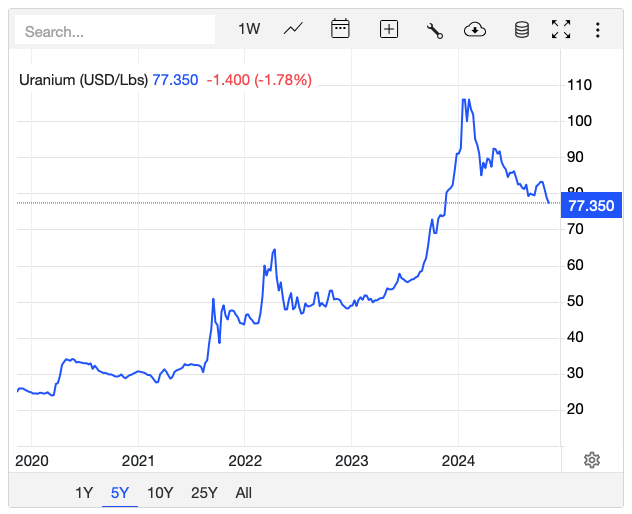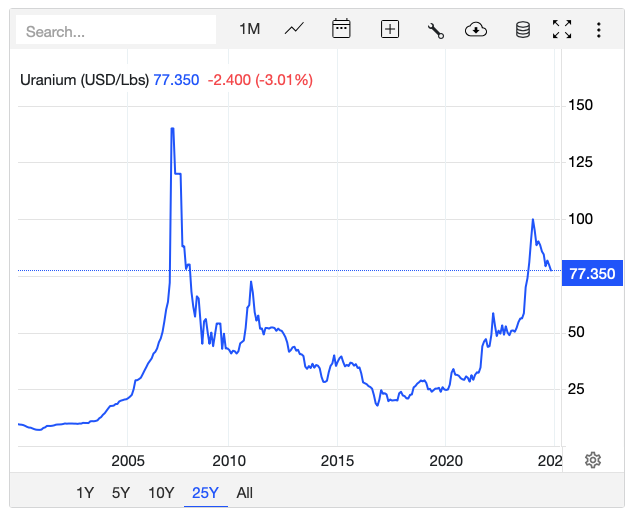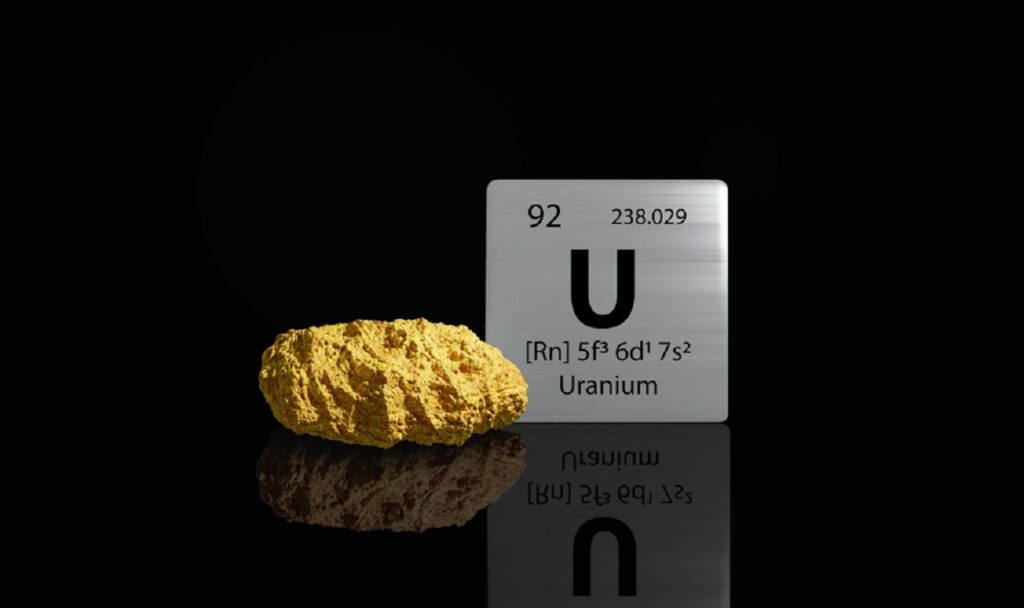Uranium is a hot commodity right now. Over the last five years, its price has shot up from around $25/lb to $77/lb – a gain of more than 200%. In this report, we are going to look at how to invest in uranium. We’ll highlight some of the best uranium stocks and ETFs to consider, and also discuss the risks involved in investing in this niche commodity.
What is uranium and what is it used for?
Uranium is a naturally occurring radioactive element that’s found in low concentrations in soil, rock, and water. About 500 times more common than gold, it’s mined in a range of countries including Australia, Canada, Russia, Kazakhstan, South Africa, and the US.
Uranium’s main use is as a fuel for nuclear energy. In a nuclear reactor, uranium atoms are bombarded by smaller neutron particles and this releases heat energy, which is used to create electricity.
One key feature of uranium is that it’s a highly efficient energy source. According to the International Atomic Energy Agency, an egg-sized amount of uranium fuel can provide as much electricity as 88 tonnes of coal.
Why has the uranium price gone up?
Uranium’s role in the nuclear energy industry is one reason its price has surged over the last five years.
Recently, the nuclear energy industry has come into focus because governments have been looking for clean sources of energy and Big Tech companies like Amazon and Microsoft have been looking for new ways to power their data centres. This has increased demand for uranium.
At the same time, supply has been tight. Currently, there is a shortfall between the amount of uranium being mined and the amount needed for nuclear energy projects globally.
Geopolitical dynamics add further complications to the supply and demand landscape. Today, Russia is one of the world’s largest producers of uranium and it has been threatening to restrict exports in retaliation for Western sanctions.

Source: Trading Economics
Uranium price forecasts
Looking ahead, many experts expect uranium prices to continue climbing in the coming years due to the supply and demand dynamics. Analysts at Bank of America, for example, believe that uranium prices could rise to $135/lb by 2026 due to market dynamics and geopolitical factors. Analysts’ forecasts should be taken with a grain of salt, however. That’s because history shows that with this commodity, prices are highly unpredictable.
How has uranium performed over the long term?
Over the long term, uranium prices have been on a wild ride. Back in 2006/2007, prices shot up during the global mining boom as interest in nuclear energy increased and speculative investment flooded the market. However, prices then fell sharply due to several factors including the Global Financial Crisis (GFC) of 2008/2009 and the Fukushima nuclear disaster in 2011.

Source: Trading Economics
Uranium stocks
Investing in publicly-traded companies that are involved in uranium mining or uranium investing is one way to get exposure to this commodity. When uranium prices are rising, these stocks can do well.
Some well-known uranium stocks include:
- Yellow Cake (YCA:LON) – Yellow Cake is an AIM-listed company that provides investors with direct exposure to uranium through a physical holding of uranium oxide concentrate (U3O8). At 30 June 2024, the company owned 21.7m pounds of uranium oxide concentrate – around 15% of 2023 of global uranium production.
- Cameco Corporation (CCJ:NYSE) – Listed in the US, Cameco is one of the world’s largest publicly-traded uranium companies. Today, utilities businesses around the world rely on the company to provide uranium fuel solutions for the generation of nuclear power.
- Uranium Energy Corp (UEC:NYSE) – Uranium Energy Corp is a fast-growing uranium mining company that has operations in the US and Canada. The owner of one of the most significant uranium resource portfolios in the Western hemisphere, it is generating revenue from its operations today.
- Neo Energy Metals (NEO:LON) – Neo Energy Metals is a UK-listed company that is focused on uranium mining in South Africa. Currently, its projects are still in the early stages of development so the company is not generating any revenues or profits yet.
It’s worth noting that uranium stocks tend to be quite risky. With uranium companies, there are a lot of factors that can result in share price weakness including mining operation setbacks, capital raisings, and lower uranium prices. So, investors should carefully weigh the risks against the potential rewards before allocating capital to them.
Uranium ETFs
Uranium ETFs can be a good way to get broad exposure to the uranium ecosystem. Typically, these ETFs provide exposure to a range of companies that are engaged in the mining and production of the commodity meaning that they can reduce stock-specific risk for investors.
Some popular uranium ETFs include:
- Global X Uranium UCITS ETF (URNU:LON) – This ETF provides exposure to a range of companies involved in the mining of uranium. Available on platforms such as Hargreaves Lansdown, Trading 212, and eToro, it has an ongoing fee of 0.65%.
- VanEck Uranium and Nuclear Technologies UCITS ETF (NUCG:LON) – With this ETF, investors get exposure to companies involved in both uranium mining and nuclear energy as well as exchange-listed funds that track the spot price of uranium or invest in physical uranium. Available on Hargreaves Lansdown, AJ Bell, Trading 212, and IG, it has an ongoing charge of 0.55%.
- HANetf Sprott Junior Uranium Miners UCITS ETF (URNJ:LON) – This ETF provides access to small- and mid-cap uranium miners. Available on Hargreaves Lansdown, it has an ongoing fee of 0.85%.
Can you trade uranium directly?
Currently, it’s not possible for retail traders to trade uranium directly with CFDs, spread bets, or futures. However, there are some other products that offer direct exposure to the commodity. One example here is the Sprott Physical Uranium Trust (U.UN:TSX). It’s a physical uranium fund that invests in uranium in the form of U3O8. The aim of this product is to provide investors with a liquid and convenient way to own physical uranium. Available on several platforms including Hargreaves Lansdown, AJ Bell, IG, and eToro, it has a management expense ratio of 0.60%.
Summary
- Uranium looks set to play a major role in the nuclear energy boom.
- There are several ways to invest in uranium today.
- Uranium stocks are risky but could do well if uranium prices continue to rise.
- Uranium ETFs offer diversified exposure to the market and can help investors reduce stock-specific risks.
- There are products that offer direct exposure to U3O8 uranium.

Based in London, Edward is a distinguished investment writer with an extensive client portfolio comprising a diverse array of prominent financial services firms across the globe. With over 15 years of hands-on experience in private wealth management and institutional asset management, both in the UK and Australia, he possesses a profound understanding of the finance industry.
Before establishing himself as a writer, Edward earned a Commerce degree from the prestigious University of Melbourne. Complementing his academic background, he holds the esteemed Investment Management Certificate (IMC) and is a proud holder of the Chartered Financial Analyst (CFA) qualification.
Widely recognized as a sought-after investment expert, Edward’s insightful perspectives and analyses have been featured on sites such as BlackRock, Credit Suisse, WisdomTree, Motley Fool, eToro, and CMC Markets, among others.
You can contact Ed at edward@goodmoneyguide.com




